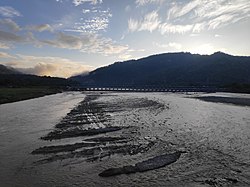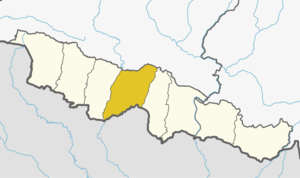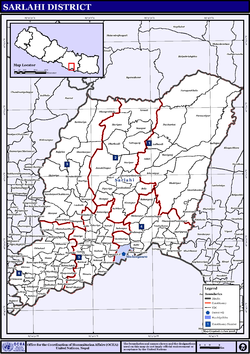Sarlahi District
सर्लाही जिल्ला | |
|---|---|
 | |
 Sarlahi District (dark yellow) in Madhesh Province | |
| Country | |
| Region | Mithila |
| Province | Madhesh |
| Admin HQ. | Malangwa |
| Government | |
| • Type | Coordination committee |
| • Body | DCC, Sarlahi |
| Area | |
| • Total | 1,259 km2 (486 sq mi) |
| Population (2021) | |
| • Total | 862,470 |
| • Density | 690/km2 (1,800/sq mi) |
| Time zone | UTC+05:45 (NPT) |
| Telephone Code | 046 |
| Main Language(s) | Bajjika, Maithili and Nepali |
| Website | www |
Sarlahi (Nepali: सर्लाही ; Maithili: सर्लाही), a part of Madhesh Province, is one of the seventy-seven districts of Nepal. According to new laws, a combination of more than two or four villages makes a municipality, which covers an area of 1,259 km2 (486 sq mi) and had a population of 635,701 in 2001,769,729 in 2011 and 862,470 in 2021 .[1]
It is bordered to the west by Rautahat district, to the east by Mahottari district, to the north by Sindhuli district of Bagmati Province, and to the south by the Indian state of Bihar.
Etymology
[edit]Generally, the people of Sarlahi believe that the name Sarlahi comes from the name of the Sarla Devi temple. The Sarla Devi temple is situated in Hempur village in the Sarlahi district. There is a belief that if someone goes to the temple at night with a light, then that person will die. For that reason, people still do not go at night to that temple with light. There are no residences around this temple.[2]
Major products
[edit]Lalbandi supplies the tomato demand of the whole country. The biggest Tropical Horticulture center of Nepal also known as Ushnapradesiya Bagwani kendra lies in the Labandi municipality of the district. The Ushnapradesiya Bagwani kendra is famous for the production of Mangoes, Litchis, scientific production of Tomatoes, and myriad species of flowers.
Barhathwa is famous for fish production and export.
The production of sugarcane and oil seeds also seems to be significant in the district. The Indushankar Chini Udhyog Ltd. (Indushankar Sugar Mills) is a notable factory in the district.[2]
The Annapurna Sugars and General Industries Pvt Ltd. is probably one of the largest sugar mills in the country, located in Dhankaul VDC of Sarlahi. The plant commenced trial operations on January 17, 2014, with a successful crushing of over 16 lakh quintals (160,000 tons) of cane. The mill will substantially help in meeting sugar requirements of the local Nepal market by producing around 300,000 quintals of white sugar. The mill is equipped with modern machinery to produce high-quality sugar. It helps to support the livelihood of thousands of people including farmers, employees and laborers. [3]
Temples and other historic sites
[edit]- The famous temple, Chameli Mai lies in Salempur of Sarlahi District where number of devotees from Country and a part of India come to seek blessing .
- The historical Nunthar Pahad is located in a strategic place bordering four districts: Makawanpur, Sarlahi, Rautahat and Sindhuli.
- The Mukteshwar Nath temple in Murtiya village is a World Heritage site.[clarification needed]
- The Nadiman lake, an important Puranic place, is located nearby Malangawa which is believed to be the yaksha pool (kunda), the mystic lake owned by the yaksha himself. The Pattharkot temple is also the best known religious place there.
- The Sitlamai temple, Bajrangbali temple, Durga temple, Gadhimai temple and Laxmipur Pokhari in Balara Municipality.[clarification needed]
- The Sagaranatha temple in Iswarpur, the Gopalkuti Mahadev temple in Karmaiya, among many others, are equally significant places in Sarlahi.
- The most emerging city and the main trading site of the Sarlahi district is Lalbandi and is also known as the education hub of the district. It is located in Lalbandi municipality which is the largest municipality of the district too.
Geography and climate
[edit]| Climate Zone[4] | Elevation Range | % of Area |
|---|---|---|
| Lower Tropical | below 300 meters (1,000 ft) | 88.3% |
| Upper Tropical | 300 to 1,000 meters 1,000 to 3,300 ft. |
11.7% |
Geographical division
[edit]According to geographical texture, Sarlahi district is divided into three parts.[5]
- Chure Hills of North
- Bhabar region of middle
- Terai region of south
Chure mountain
[edit]On the north side of the district from east to west is the mountain range known as the Sivalik Hills. They have an average height of 900 metres (3,000 ft), reaching 1,350 metres (4,430 ft) in places. This range separates the Terai from the inner Terai and harbours the fossilised remains of many mammals no longer typical of Eurasia.[6]

Bhabar region
[edit]This region is between Chure range and the Outer Terai region. In the local language, it is also known as Char koshe Jhadi. The height of the region is from 150 to 300 metres (490 to 980 ft). The Mahendra Highway touches this area, so settlement is increasing. In the region, the water source level is always very low; even the following water disappears because of sandiness. It is very difficult to obtain water by digging. Irrigation is problematic in the area.[5]
Terai region
[edit]The Terai region, plains, forms the southernmost part of Nepal and goes to India's Bihar. Since ancient times, the region has had large public density and is a good place for farming, so it is called Treasurer of grain.[5]
Rivers
[edit]There are four major rivers in this district that flow into India: the Bagmati & Manushmara river "(sisaut)" the Hardi (Banke), the Lakhandei and the Jhim. However, there are around a dozen other small rivulets that originate from the Chure hills and flow down the plain. They are actually the tributaries of the three major river systems of the district. These small rivulets are the Hariwan khola, the Dhungre khola, the Soti khola, the Sotraha khola, the Chapini khola, the Pathlaiya khola, he Kalinjor khola, the Phooljor khola and the Banke Khola. The Banke Khola is the eastern demarcation of the district separating it from Mahottari district, whereas the Bagmati river flows between Sarlahi and Rautahat districts.
- Bagmati river system: it is the largest river, flowing in the western side of district separating Rautahat district from Sarlahi.
- Lakhandei river system: this river is the largest river inside the district; it is about 25 kilometers long. It originates from the Chure Mountain range, the lowest foothills of the Great Himalayan ranges. It flows into India by touching Simara village development committee (VDC) of this district.
- Jhim river system: originating from the northeast side of the Chure mountains of this district into the Phuljor and Kalinjor rivers, it joins at the Vairawpur village of Jabdi VDC, then it becomes Jhim river. It is 29 km (18 mi) long and by flowing into districts passes into India, and in India this river is known as Adhwara river. Adhwara river was the east border of Makwanpur region.
Banke (Hardi Nadi) river. Banke river was the east border of Sarlhi district. There are also many rivers in this district including the Adhwara River of the east which empties into the Jhim River, Manushmara river (which is formed by mixing Harion, Sotara and Pathlaiya rivers), and in middle of the district Dhangra and Bhumi rivers.[5]
- Bhatauliya river system: this river is the medium river inside the district; it is about 10 kilometers long. It originates from the Soram range. It flows into India by touching Bhatauliya VDC of this district.
Demographics
[edit]| Census year | Pop. | ±% p.a. |
|---|---|---|
| 1981 | 398,766 | — |
| 1991 | 492,798 | +2.14% |
| 2001 | 635,701 | +2.58% |
| 2011 | 769,729 | +1.93% |
| 2021 | 857,360 | +1.08% |
Graphs are unavailable due to technical issues. There is more info on Phabricator and on MediaWiki.org. | ||
| Source: Citypopulation[7] | ||
At the time of the 2011 Nepal census, Sarlahi District had a population of 769,729.
As their first language, 49.0% spoke Bajjika, 21.3% Maithili, 11.8% Nepali, 6.3% Urdu, 4.8% Tamang, 2.1% Tharu, 1.4% Magar, 0.9% Bhojpuri, 0.5% Danuwar, 0.4% Newar, 0.3% Hindi, 0.2% Majhi, 0.1% Awadhi, 0.1% Baitadeli, 0.1% Magahi, 0.1% Rai, 0.1% Sunuwar and 0.1% other languages.[8]
Ethnicity/caste: 15.5% were Yadav, 7.9% Koiri/Kushwaha, 7.9% Musalman, 5.4% Teli, 5.2% Tamang, 3.7% Chhetri, 3.7% Dusadh/Paswan/Pasi, 3.6% Hill Brahmin, 3.6% Chamar/Harijan/Ram, 2.8% Tharu, 2.7% Mallaha, 2.6% Kalwar, 2.2% Kathabaniyan, 2.2% Kurmi, 2.0% Magar, 1.9% Terai Brahmin, 1.8% Musahar, 1.7% Lohar, 1.6% Dhanuk, 1.4% Kumhar, 1.3% Dhobi, 1.3% Hajam/Thakur, 1.3% Kanu, 1.2% Bin, 1.2% Nuniya, 1.2% Tatma/Tatwa, 1.1% Danuwar, 1.1% Sonar, 1.0% Newar, 1.0% Sudhi, 0.9% Kami, 0.9% Khatwe, 0.8% Rajput, 0.7% Baraee, 0.6% Majhi, 0.5% Halwai, 0.5% Kewat, 0.4% Kayastha, 0.4% Sanyasi/Dasnami, 0.3% Damai/Dholi, 0.3% Gharti/Bhujel, 0.3% Marwadi, 0.2% Dhunia, 0.2% Mali, 0.2% Rai, 0.2% Sarki, 0.2% other Terai, 0.1% Badhaee, 0.1% Bote, 0.1% Dom, 0.1% Gaderi/Bhedihar, 0.1% Kahar, 0.1% Kumal, 0.1% Punjabi/Sikh, 0.1% Sunuwar, 0.1% Thakuri and 0.2% others.[9]
| Religions in Sarlahi (2011) | ||||
|---|---|---|---|---|
| Religion | Percent | |||
| Hindus | 85.56% | |||
| Muslims | 7.88% | |||
| Buddhists | 5.71% | |||
| Other or not stated† | 0.85% | |||
| Distribution of religions †Includes kirats, Jainism (<0.001%). | ||||
[10] [11] Religion: 85.6% were Hindu, 7.9% Muslim, 5.7% Buddhist, 0.3% Prakriti, 0.2% Christian and 0.3% others.[12]
Literacy: 46.3% could read and write, 2.8% could only read and 50.8% could neither read nor write.[13]
Media
[edit]From Sarlahi district, newspapers and FM radio stations are as follows:[14]
Newspapers: Loktantra Dainik, Paricharcha, Madhesh Post Daily, Suchna Saugat Weekly, Sarlahi Awaz Weekly, and Sarlahi Times Weekly.
| Name | Frequency Range | Location | Status→←≥ |
|---|---|---|---|
| Samudayak Radio Sarlahi | 105.7 MHz | Hariyon | Broadcast |
| Swarnim FM | 96.3 MHz | Malangwa | Broadcast |
| Radio Madhesh | 89.3 MHz | Malangwa | Broadcast |
| Radio Ekta | 92.4 MHz | Lalbandi | Broadcast |
| Radio Dhukdhuki | 95.6 MHz | Lalbandi | Broadcast |
| Radio Mukteshower | 100.4 MHz | Barahatwa | Broadcast |
| Radio Barahathawa | 101.1 MHz | Barahathawa | Broadcast |
Sarlahi constituencies
[edit]There are a total of four electoral consttituncies for Hosur of Representatives and eight for Provincial assembly which are as below.[15]
Administration
[edit]The district consists of twenty municipalities, out of which eleven are urban municipalities and nine are rural municipalities. These are as follows:
- Bagmati Municipality
- Balara Municipality
- Barahathwa Municipality
- Godaita Municipality
- Harion Municipality
- Haripur Municipality
- Haripurwa Municipality
- Ishworpur Municipality
- Kabilasi Municipality
- Lalbandi Municipality
- Malangwa Municipality
- Basbariya Rural Municipality
- Bishnu Rural Municipality
- Brahampuri Rural Municipality
- Chakraghatta Rural Municipality
- Chandranagar Rural Municipality
- Dhankaul Rural Municipality
- Kaudena Rural Municipality
- Parsa Rural Municipality
- Ramnagar Rural Municipality
Former Village Development Committees (VDCs)
[edit]
- Achalgadh
- Arnaha
- Aurahi
- Babarganj
- Bagmati Municipality,Karmaiya,Sarlahi
- Bagdaha
- Bahadurpur
- Balara
- Bara Udhoran
- Barahathawa
- Basantapur
- Batraul
- Bela
- Belhi
- Belwajabdi
- Bhadsar
- Bhagawatipur
- Bhaktipur
- Bhawanipur
- Brahmapuri
- Chandranagar
- Chhataul
- Chhatona
- Dhankaul Pachhawari
- Dhanakaul Purba
- Dhangada
- Ghurkauli
- Dhungrekhola
- Dumariya
- Gadahiyabairi
- Gamhariya
- Godeta
- Gaurishankar
- Hajariya
- Harakthawa
- Haripur
- Haripurwa
- Hariwan Municipality
- Hathiyol
- Hempur
- Ishwarpur
- Jabdi
- Jamuniya
- Janaki Nagar
- Jingadawa
- Kabilasi
- Kalinjor
- Karmaihiya
- Khairwa
- Khoriya
- Khutauna
- Kisanpur
- Kaudena
- Lalbandi
- Laukat
- Laksmipur Kodraha
- Laksmipur Su.
- Madhubangoth
- Mahinathpur
- Mailhi
- Malangawa Municipality
- Manpur
- Masaili
- Mirjapur
- Mohanpur
- Motipur
- Murtiya
- Musauli
- Narayan Khola
- Narayanpur
- Netraganj
- Naukailawa
- Parsa
- Parwanipur
- Pattharkot
- Pharahadawa
- Phulparasi
- Pidari
- Pidariya
- Pipariya
- Rajghat
- Ramnagar Bahuarwa
- Ranban
- Raniganj
- Rohuwa
- Sakraul
- Salempur
- Sangrampur
- Sankarpur
- Shahorwa
- Shreepur
- Sikhauna
- Simara
- Sisotiya, Manharwa, Madhopur]]
- Sisaut
- Shankarpur
- Sohadawa
- Sudama
- Sundarpur
- Piprabhitta, Sundarpur Choharwa
- Tribhuwannagar
Notable people
[edit]- Sambhu Lal Shrestha, Nepali Congress leader and former Minister for Agriculture of Nepal
- Jangi Lal Ray, Nepali Congress leader and former member of Constituent Assembly
- Amresh Kumar Singh, Nepali Congress leader and member of House of Representatives
- Rajendra Mahato, Sadbhawana party politician and former minister who left district for election purpose after unsuccessful attempts in general elections
- Mahendra Raya Yadav, member of House of Representatives and Minister for Agriculture of Nepal
- Pramod Sah, member of House of Representatives
- Birendra Prasad Singh, Nepali Congress leader, member of Provincial Assembly and Minister in Government of Madhesh Province.
- Nikhil Upreti, a well known Nepali actor and Producer. He has worked in numbers of Nepali Movies like Pijada, Dhadkan, Hami Tin Bhai, Bhairab and so on.
- Gulsan Jha, A national cricketer who has played so many games for Nepal and is currently playing for Nepal.
See also
[edit]- Zones of Nepal
- "Districts of Nepal". Statoids.
References
[edit]- ^ "National Population and Housing Census 2011 (National Report)" (PDF). Central Bureau of Statistics. Archived from the original (PDF) on 2013-05-25. Retrieved 1 November 2012.
- ^ a b जिल्ला विकास समितिको कार्यालय, सर्लाही. "जिविसको वस्तुगत स्थितिको झलक". Archived from the original on 2014-06-06. Retrieved 2013-12-12.
- ^ "Ivermectinop.online".
- ^ The Map of Potential Vegetation of Nepal - a forestry/agroecological/biodiversity classification system (PDF), Forest & Landscape Development and Environment Series 2-2005 and CFC-TIS Document Series No.110., 2005, ISBN 87-7903-210-9, retrieved Nov 22, 2013
- ^ a b c d जिल्ला विकास समितिको कार्यालय, सर्लाही. "भौगोलिक अवस्थिति". Archived from the original on 2014-06-06. Retrieved 2013-12-12.
- ^ "Geography of Nepal". nepaltourtravels.com. Retrieved 2013-12-12.
- ^ "NEPAL: Administrative Division". www.citypopulation.de.
- ^ NepalMap Language [1]
- ^ NepalMap Caste [2]
- ^ "Archived copy" (PDF). Archived from the original (PDF) on 2019-01-07. Retrieved 2013-12-26.
((cite web)): CS1 maint: archived copy as title (link) - ^ 2011 Nepal Census, Social Characteristics Tables
- ^ NepalMap Religion [3]
- ^ NepalMap Literacy [4]
- ^ sarlahi development. "News Paper Publish in Sarlahi District". Retrieved 2013-12-12.
- ^ http://election.gov.np/election/uploads/files/document/%E0%A4%AE%E0%A4%A4%E0%A4%A6%E0%A4%BE%E0%A4%A8_%E0%A4%95%E0%A5%87%E0%A4%A8%E0%A5%8D%E0%A4%A6%E0%A5%8D%E0%A4%B01.pdf [bare URL PDF]
External links
[edit]Headquarters: Malangwa | ||
| Municipalities: 11 | ||
| Rural municipalities: 9 | ||
